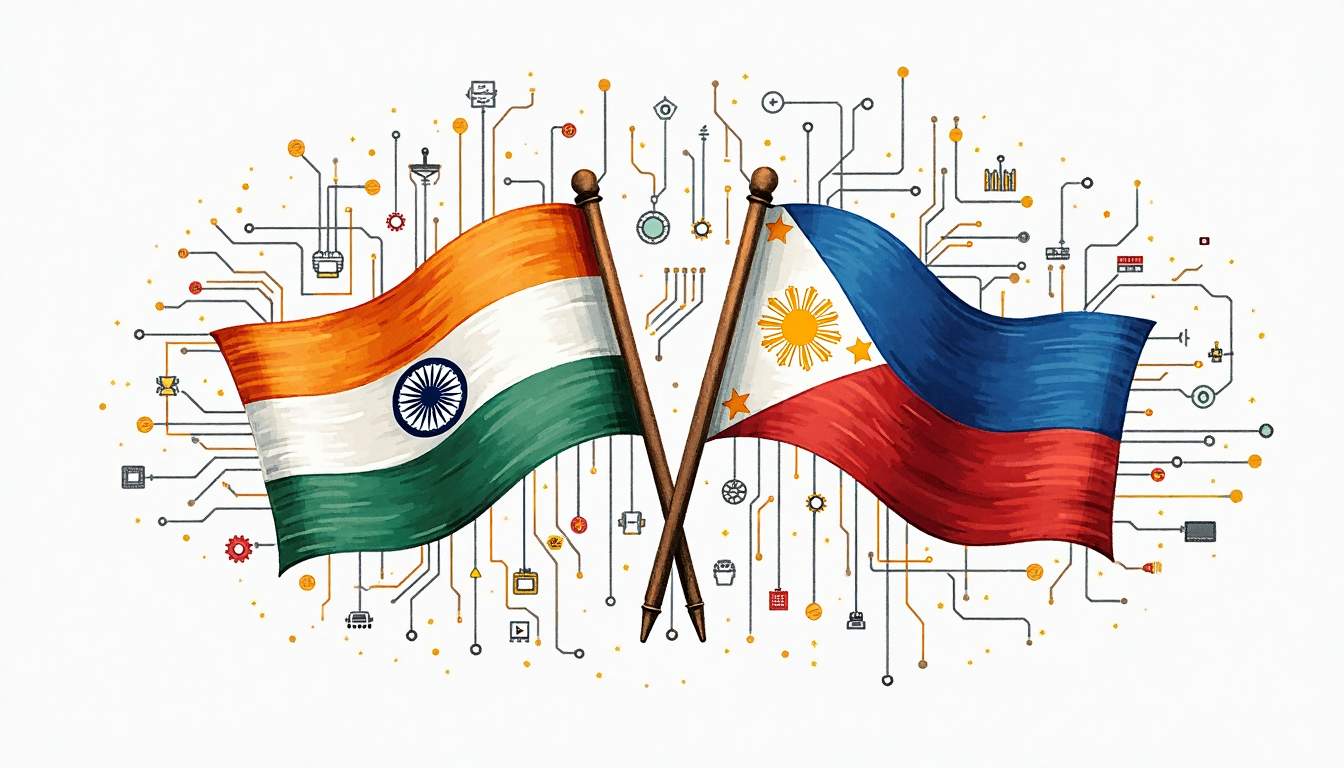Software Development Outsourcing India vs Philippines 2025
As the global demand for software development continues to surge, companies increasingly look beyond their borders to find the best talent at competitive costs. India and the Philippines have emerged as two of the most prominent destinations for outsourcing software development. Both countries offer unique advantages, but understanding their differences is crucial for businesses aiming to make informed decisions in 2025 and beyond.
This article provides an in-depth comparison of software development outsourcing in India and the Philippines, covering market size, developer quality, communication skills, cultural fit, government support, and industry-specific recommendations. By the end, readers will have a clearer perspective on which destination aligns best with their project needs and business goals.
Market Size and Maturity Comparison
India's software development outsourcing market is one of the largest and most mature globally. According to NASSCOM, the Indian IT-BPM industry generated approximately $245 billion in revenue in 2023, with software development services accounting for a significant portion. The country boasts over 5 million IT professionals, with a steady annual growth rate of around 7-8%. This maturity translates into a well-established ecosystem of service providers ranging from startups to multinational corporations. The Indian market is also characterized by its strong emphasis on innovation, with numerous tech hubs emerging across cities like Bengaluru, Hyderabad, and Pune. These hubs not only foster a competitive environment but also encourage collaboration between academia and industry, ensuring a continuous pipeline of skilled talent.
In contrast, the Philippines is a rapidly growing player in the software outsourcing landscape. While traditionally known for its strengths in business process outsourcing (BPO), the country has made significant strides in software development over the past decade. The Philippine IT-BPM industry reported revenues exceeding $40 billion in 2023, with software development services growing at an impressive rate of 15-20% annually. The talent pool, though smaller—estimated at around 400,000 IT professionals—is expanding quickly, supported by government initiatives and increasing foreign investments. The Philippine government has implemented various programs aimed at enhancing the skill sets of its workforce, including partnerships with educational institutions to align curricula with industry needs, thereby ensuring that graduates are job-ready and equipped with the latest technological skills.
When comparing market maturity, India offers a more extensive and diverse vendor landscape with decades of experience servicing global clients. The Philippines, while younger in this space, is gaining momentum and carving out a niche, particularly in agile and cloud-native development projects. Companies seeking a mature and vast market may lean towards India, whereas those looking for emerging opportunities with competitive pricing might consider the Philippines. Furthermore, the Philippines is increasingly recognized for its cultural affinity with Western clients, which facilitates smoother communication and collaboration. This cultural alignment, combined with a growing reputation for high-quality software solutions, positions the Philippines as an attractive alternative for businesses looking to diversify their outsourcing strategies.
Developer Quality and Technical Skills
India has long been recognized for its deep pool of highly skilled software developers. Indian engineers often graduate from prestigious institutions such as the Indian Institutes of Technology (IITs) and the National Institutes of Technology (NITs), which emphasize strong foundations in computer science, engineering, and mathematics. The country produces over 1.5 million engineering graduates annually, many of whom specialize in software development, artificial intelligence, machine learning, and data science. This educational framework not only equips students with theoretical knowledge but also encourages hands-on experience through internships and collaborative projects, allowing graduates to enter the workforce with practical skills that are immediately applicable.
Moreover, Indian developers tend to have extensive experience working with a broad range of technologies including Java, Python, .NET, and emerging fields like blockchain and IoT. Many Indian IT firms invest heavily in continuous training and certifications to keep their workforce updated with the latest industry trends and standards. This commitment to lifelong learning is reflected in the numerous hackathons, coding competitions, and tech meetups that are prevalent in cities like Bangalore and Hyderabad, fostering a culture of innovation and collaboration. As a result, Indian developers are not only adept at solving complex problems but are also skilled in adopting new technologies quickly, making them valuable assets in fast-paced development environments.
The Philippines, while having a smaller talent pool, is rapidly improving its technical capabilities. Filipino developers are increasingly proficient in popular programming languages such as JavaScript, PHP, and Python, with a growing focus on mobile app development, web technologies, and cloud computing. The government and private sector have launched various upskilling programs to enhance the technical competencies of Filipino developers, including partnerships with global tech companies. These initiatives often include mentorship programs and access to online courses, enabling developers to learn from industry leaders and gain insights into best practices in software development. Furthermore, the Philippines has a vibrant startup ecosystem that encourages innovation and entrepreneurship, providing developers with opportunities to work on cutting-edge projects.
In terms of quality, both countries produce competent developers, but India’s advantage lies in its sheer volume and depth of expertise across complex, large-scale projects. The Philippines shines in agile development environments and projects requiring quick turnaround and adaptability. Filipino developers are known for their strong communication skills and cultural affinity with Western clients, which often leads to smoother collaboration and project execution. This unique blend of technical skills and soft skills positions the Philippines as an attractive destination for companies looking to outsource projects that require not just coding prowess but also effective client interaction. Ultimately, the choice depends on the specific technical requirements and project complexity.
English Proficiency and Communication
Effective communication is vital in software development outsourcing, as it directly impacts project success and collaboration. The Philippines is renowned for its high English proficiency, consistently ranking among the top countries in the EF English Proficiency Index. English is one of the official languages and is widely used in education, government, and business. Filipino developers typically exhibit strong verbal and written communication skills, making it easier for clients to convey requirements and receive clear updates.
India also boasts a large English-speaking workforce, with English serving as a primary medium of instruction in higher education and a common language in the IT sector. However, the diversity of accents and regional dialects can sometimes pose minor challenges in communication. Despite this, Indian developers are generally well-versed in technical English and professional communication, especially those working with international clients.
When comparing the two, the Philippines often has an edge in accent neutrality and conversational fluency, which can reduce misunderstandings and improve day-to-day interactions. This makes the Philippines particularly attractive for projects requiring frequent client-developer communication or customer-facing software solutions. India, meanwhile, offers a vast talent pool with strong technical English skills, suitable for projects where written communication and documentation are paramount.
Cultural Fit and Time Zone Benefits
Cultural compatibility plays a subtle yet significant role in outsourcing partnerships. The Philippines shares many cultural traits with Western countries, especially the United States, due to historical ties and widespread exposure to American media and education. This cultural affinity often results in smoother collaboration, shared work ethics, and a better understanding of client expectations.
India’s cultural landscape is diverse, with a strong emphasis on hierarchy and formality in business settings. Indian developers are accustomed to working with global clients and have adapted to various cultural nuances over time. However, differences in communication styles and work approaches may require more deliberate management to ensure alignment.
Time zone considerations are also crucial. The Philippines operates on Philippine Standard Time (UTC+8), which aligns well with East Asian markets and offers partial overlap with European working hours. India, on Indian Standard Time (UTC+5:30), provides a good overlap with European and Middle Eastern clients and some overlap with U.S. West Coast working hours. Companies targeting North American markets might find India’s time zone more favorable for real-time collaboration during their business hours, whereas those focusing on Asia-Pacific clients may prefer the Philippines.
Government Support and Infrastructure
Both India and the Philippines have recognized the strategic importance of the IT and software development sectors and have implemented policies to foster growth. India’s government offers numerous incentives such as tax breaks, special economic zones (SEZs), and funding for tech startups. The Digital India initiative aims to enhance digital infrastructure and promote innovation nationwide. Additionally, India has a robust network of IT parks and technology hubs in cities like Bengaluru, Hyderabad, and Pune, equipped with state-of-the-art facilities.
The Philippines government actively supports the IT-BPM industry through the Information Technology and Business Process Association of the Philippines (IBPAP) and offers fiscal incentives under the Philippine Economic Zone Authority (PEZA). Investments in improving internet connectivity, power reliability, and transportation infrastructure have accelerated, particularly in Metro Manila, Cebu, and Davao. The government also prioritizes cybersecurity and data privacy regulations to align with international standards.
While both countries provide conducive environments for outsourcing, India’s infrastructure is more extensive and diversified, supporting large-scale operations. The Philippines, meanwhile, is rapidly upgrading its infrastructure and offers a business-friendly climate with streamlined processes for foreign investors. Companies should evaluate the specific location and infrastructure quality when selecting outsourcing partners in either country.
Industry-Specific Outsourcing Recommendations
Choosing between India and the Philippines for software development outsourcing often depends on the industry and project type. For sectors such as finance, healthcare, and enterprise software, India’s mature ecosystem and deep technical expertise make it a preferred choice. Indian developers have extensive experience with complex regulatory environments, large data systems, and cutting-edge technologies like AI and blockchain, which are critical in these industries.
The Philippines excels in industries that benefit from strong communication and customer engagement, such as e-commerce, travel, hospitality, and education technology. Its developers often work closely with clients to deliver user-centric applications, mobile solutions, and agile development projects. The country’s cultural affinity with Western markets also supports outsourcing for customer-facing platforms and digital marketing technologies.
Startups and small to medium enterprises (SMEs) may find the Philippines more cost-effective and flexible for rapid prototyping and iterative development. Larger enterprises with complex, multi-layered projects might prefer India’s extensive resources and specialized talent pools. Ultimately, aligning the outsourcing destination with industry requirements and project scope ensures better outcomes and long-term success.






